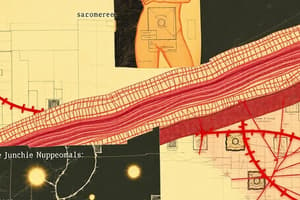Podcast
Questions and Answers
How do cardiac muscle cells assemble to form cardiac muscle?
How do cardiac muscle cells assemble to form cardiac muscle?
- In a linear, non-branching pattern.
- In a circular pattern.
- In a random, disorganized manner.
- In a branching pattern. (correct)
Which of the following accurately describes the nature of cardiac muscles?
Which of the following accurately describes the nature of cardiac muscles?
- Non-striated and involuntary
- Striated and involuntary (correct)
- Non-striated and voluntary
- Striated and voluntary
What is the role of fascia in skeletal muscles?
What is the role of fascia in skeletal muscles?
- To provide a protective barrier against infections.
- To store calcium ions for muscle contraction.
- To transmit nerve impulses to the muscle fibers.
- To hold muscle bundles together. (correct)
What is the sarcolemma?
What is the sarcolemma?
Why is a muscle fiber referred to as a syncitium?
Why is a muscle fiber referred to as a syncitium?
What is the primary function of the sarcoplasmic reticulum in muscle fibers?
What is the primary function of the sarcoplasmic reticulum in muscle fibers?
Which component is responsible for the striated appearance of myofibrils?
Which component is responsible for the striated appearance of myofibrils?
What are the two main proteins that compose the myofilaments in muscle fibers?
What are the two main proteins that compose the myofilaments in muscle fibers?
Which of the following features distinguishes skeletal muscle from cardiac muscle?
Which of the following features distinguishes skeletal muscle from cardiac muscle?
If a drug blocked the function of the sarcoplasmic reticulum, which of the following processes would be most directly affected?
If a drug blocked the function of the sarcoplasmic reticulum, which of the following processes would be most directly affected?
A scientist is studying a muscle tissue sample under a microscope and observes a branching pattern of cells. Which type of muscle tissue is the scientist most likely observing?
A scientist is studying a muscle tissue sample under a microscope and observes a branching pattern of cells. Which type of muscle tissue is the scientist most likely observing?
Which of the following is the correct order from largest to smallest?
Which of the following is the correct order from largest to smallest?
If a muscle is described as striated and involuntary, which type of muscle it would be?
If a muscle is described as striated and involuntary, which type of muscle it would be?
What would be the immediate effect of removing calcium ions from the sarcoplasm of a muscle fiber?
What would be the immediate effect of removing calcium ions from the sarcoplasm of a muscle fiber?
How does the arrangement of actin and myosin contribute to muscle function?
How does the arrangement of actin and myosin contribute to muscle function?
Flashcards
Cardiac Muscles
Cardiac Muscles
Striated, involuntary muscles forming the heart.
Muscle Bundles (Fascicles)
Muscle Bundles (Fascicles)
Bundles of muscle fibers held together by fascia.
Sarcolemma
Sarcolemma
Plasma membrane enclosing the sarcoplasm of a muscle fiber.
Sarcoplasm
Sarcoplasm
Signup and view all the flashcards
Sarcoplasmic Reticulum
Sarcoplasmic Reticulum
Signup and view all the flashcards
Myofilaments (Myofibrils)
Myofilaments (Myofibrils)
Signup and view all the flashcards
Fascia
Fascia
Signup and view all the flashcards
Syncitium
Syncitium
Signup and view all the flashcards
Actin and Myosin
Actin and Myosin
Signup and view all the flashcards
Study Notes
- Cardiac muscles are the muscles of the heart.
- Cardiac muscle cells assemble in a branching pattern to form a cardiac muscle.
- Cardiac muscles are striated in appearance.
- Cardiac muscles are involuntary because the nervous system does not directly control their activities.
- Skeletal muscles are examined in detail to understand the structure and mechanism of contraction.
- Organised skeletal muscle is made of muscle bundles or fascicles.
- Fascicles are held together by a collagenous connective tissue layer called fascia.
- Each muscle bundle contains muscle fibres.
- Each muscle fibre is lined by the plasma membrane called the sarcolemma, enclosing the sarcoplasm.
- Muscle fibre is a syncitium because the sarcoplasm contains many nuclei.
- The sarcoplasmic reticulum of the muscle fibres stores calcium ions.
- Muscle fibres contain parallelly arranged filaments in the sarcoplasm called myofilaments or myofibrils.
- Each myofibril has alternating dark and light bands.
- Striated appearance is due to the distribition of actin and myosin proteins.
Studying That Suits You
Use AI to generate personalized quizzes and flashcards to suit your learning preferences.




